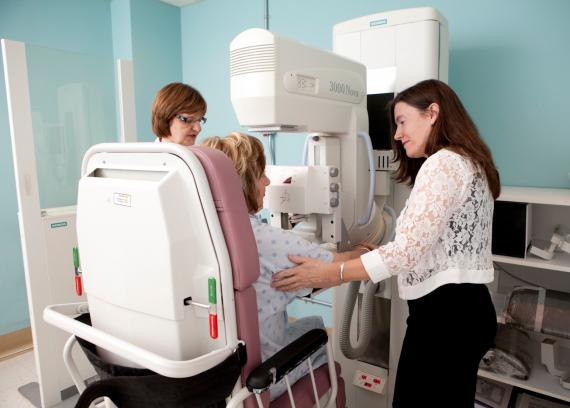
Quality & Patient Safety
Quality and Patient Safety in Diagnostic Imaging
Quality is the foundation in which diagnostic imaging is practised by radiologists in a modern health care system for the purpose of constantly improving diagnostic accuracy and for the earlier detection of disease, considered a vitally important determinant of improved patient care outcomes.
Quality appears in many forms in radiology including accreditation, peer review, evidence-based imaging, quality control, radiation safety, infection control and many other aspects that related to the delivery of patient care services by Ontario radiologists.
“We wish to assure every patient in Ontario that your radiologist remains steadfastly committed to providing the highest level of professional care possible.Radiologists take these quality and patient safety issues seriously and ensure that such quality improvements are adopted.”

Role of Accreditation in Diagnostic Imaging
Diagnostic Imaging accreditation relies on defined consensus expert practice guidelines and technical standards. Such standards outline:
- Evidence-based recommendations and guidelines of best practice across clinical care, facilities/equipment and workforce, patient experience, and safety
- Standards of practice and technical standards have generally been most effectively developed through extensive and ongoing consultative and consensus programs involving health professionals and organizations
Accreditation is a formal, third party recognition of competence to perform specific tasks. Specifically related to medical imaging, accreditation is an independent attestation of an organization’s competence, using defined standards, to provide diagnostic imaging services (processes & performance) such that users have confidence in the outcomes.
Accreditation has become ubiquitous across the international health care landscape as an indicator of quality performance, and medical imaging accreditation programs have been well established in Canada and the United States for many years.
Components of a Diagnostic Imaging Accreditation Program
- Personnel Qualifications (Qualifications, Continuing Experience, Continuing Education)
- Interpreting Physician, Radiology Technologist, Medical Physicist
- Equipment (standards, safe operating procedures)
- Patient and Personnel Safety (policies, radiation, magnetic field, etc.)
- Quality Control (practices, equipment, protocols, clinical images, positioning)
- Quality Assurance (physician peer review, appropriateness/outcomes)
- Results Reporting (timeliness, communication, record keeping)
- Patient Complaints/ Incident Reporting
Quality Assurance is Enshrined in Legislation & Regulation
Diagnostic Imaging is the most regulated area of medicine with extensive provincial and federal legislation addressing a wide spectrum of quality and patient safety issues
Key Pieces of Ontario Legislation
- Public Hospitals Act
- Independent Health Facilities Act (IHFA)
- Health Insurance Act & the Schedule of Benefits
- Healing Arts Radiation Protection Act (HARP)
- Regulated Health Professionals Act
- Medicine Act
- Commitment to the Future of Medicare Act
- Personal Health Information Protection Act (PHIPA)
- Quality of Care Information Protection Act (ACIPA)
Key Pieces of Federal Legislation
- Food and Drugs Act
- Radiation Emitting Devices Act
- Nuclear Safety and Control Act
- Canadian Nuclear Safety Commission
Public Hospitals
- Hospital Credentialing Process
- Hospital Privileges Process
- Radiologist-in-Chief leadership role
- Radiation Protection Officer
- Equipment Planning and Purchase
- MRT technical supervision
- Infection Control
- Medical Advisory Committee membership
- Hospital quality care committee membership
Independent Health Facility (IHF) Radiology Clinics
- MOH IHFA Quality Assessment process administered by CPSO
- Quality Advisor
- Radiation Protection Officer
- Equipment Planning and Purchase
- MRT technical supervision
- Infection Control
- Quality Assurance Committee
- Clinical Practice Parameters for IHFs
- OAR Quality Control Manual for IHFs
Ministry of Health & Long-Term Care
- Wait Time Priority Advisory Board
- Ontario Health Technology Assessment Committee
- HARP Committees – Radiation Safety
- MRI Safety
- CT & MRI Scanner approval process
- X-ray Inspections
- eHealth Regional DI Repositories
- Workplace and Occupational Safety
- LHIN DI Advisory and Planning Committees
Cancer Care Ontario
- Ontario Breast Screening Program
- OBSP Breast Assessment Program
- OBSP High Risk Breast Cancer Program
- Quality Management Program (in conjunction with MOH/CPSO)
- Cancer Care Imaging Clinical Leadership
- Colo-rectal Cancer Survivorship Program
College of Physicians & Surgeons of Ontario
- IHF Task Force on Radiology
- IHF Task Force on Nuclear Medicine
- MOH IHF Quality Assessment review program
- Physician Audits
Accreditation Programs in Diagnostic Imaging
Bone Mineral Densitometry Accreditation Ontario Association of Radiologists
Mammography Accreditation Canadian Association of Radiologists
Computed Tomography American College of Radiology
Magnetic Resonance Imaging American College of Radiology
Nuclear Medicine American College of Radiology
Positron Emission Tomography American College of Radiology





